
1. ASME Certificate 의의
2. ASME Code의 구성
3. ASME CODE에 관한 인증자격의 종류
4. ASME 자격의 취득
5. 공인검사(NCA-5000)
6. 각 인증의 비교
7. ASME Sec. III 인증추진 절차
8. ASME에 대하여 자주 나오는 질문
2. ASME Code의 구성
3. ASME CODE에 관한 인증자격의 종류
4. ASME 자격의 취득
5. 공인검사(NCA-5000)
6. 각 인증의 비교
7. ASME Sec. III 인증추진 절차
8. ASME에 대하여 자주 나오는 질문
1. ASME Certificate 의의
ASME의 자격인증제도는 ASME Boiler and Pressure Vessel Code라는 규격의 요구에 따라 설계, 제작, 시공 등 여러 가지 활동을 할 수 있는 자격이 있는 회사를 인증하기 위한 절차를 설정한 것이다. 이 자격을 갖고 있는 회사는 ASME Code의 요건에 따라 품목을 설계, 제작, 설치하고 Authorized Inspection Agency(공인검사기관)의 소정의 검사를 받은 후 ASME Code의 모든 요건을 만족하였다는 표시로서 ASME의 Stamp를 제품에 각인함으로서 궁극적으로 품목이 일정수준의 품질을 유지하고 있음을 객관적으로 증명하게 된다. ASME는 보일러나 압력 용기 등 기기의 사용자, 감독관청 및 이들 Certificate의 보유자 자체의 이익을 위하여 ASEM Code Symbol Stamp의 권위를 유지하고자 노력하고 있다. 오랜 경험을 통해 축적된 기술을 담고 있는 ASME Code의 기술적 요건과 품질프로그램 등 관리요건을 만족하고 그 위에 공인 검사기관에 의한 독립적 검사에 의해 그 품질이 확인된 것만으로도 유례를 찾을 수 없을 만큼 엄격한 품질보증제도임을 알 수 있다.
2. ASME Code의 구성
2.1 구성
|
2,2 각 Section간의 관계
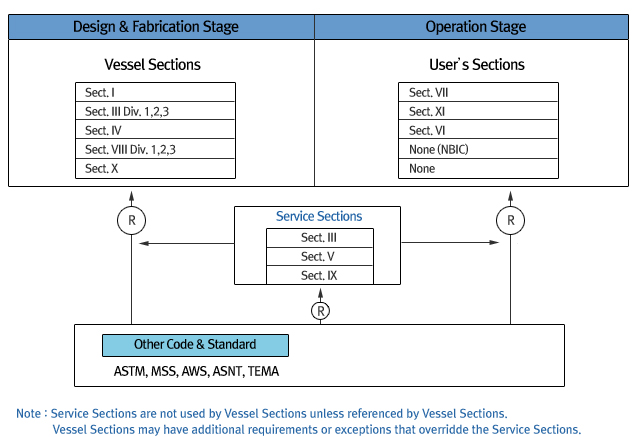
2.3 ASME Sec.III의 구성
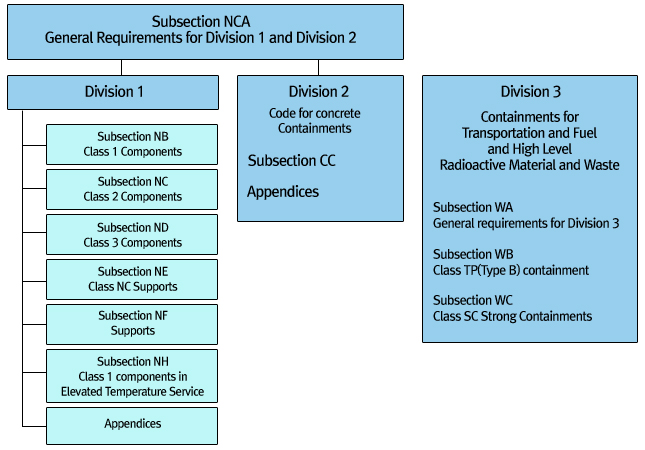
3. ASME CODE에 관한 인증자격의 종류
3.1 대상조직
2) 재료의 제조 또는 설치자(Material Manufacturer라고 부른다)
3) 재료의 보관, 공급자(Material Supplier라고 부른다)
4) 기기의 제조자(Manufacturer, Constructor, Certificate Holder, Holder of Certificate of Authorization이라고 부른다)
5) Service의 하청업자(비파괴시험, 열처리, Bending, 가공, 보수 등의 Service 제공자)
6) 설계자(Section Ⅲ, Division 2에서는 Designer라고 부르며, 그 외의 경우는 상기의 Service 하청업자로 분류될 수 있다)
Certificate of Authorization incl NS and Corporate
QA Program Certificate
Quality System Certificate
Owner's Certificate
NA - Field installation and shop assembly
NPT - Fabrication, with or without design responsibility, for nuclear appurtenances and supports
NS - Nuclear supports
NV - Pressure relief valves
N3 - Containment for spent fuel and radioactive waste
Product Forms
3.2 ASME 인증
Service의 하청업체는 발주자에 의해 그 자격이 인증되는 것만이 요구되고 ASME에 의한 인증제도는 없다. 또 설계자는 Engineering Organization으로서의 ASME 인증제도가 있었지만 폐지되었으며 Service 하청업체와 동일하게 취급된다
원자력 이외의 경우는, 기기의 제조자와 조립설치업자만이 자격인증의 대상이며, 그외의 단체에 대한 특별한 요구는 없다. 이 자격은 특정의 Certification Marks를 부여하여, 그것을 제품에 표시하는 것을 허가하는 것과 특정의 Stamp는 없지만, 특정의 책임, 권한을 부여하여, 서류의 증명 등에 따라 그것을 표시하는 것으로 아래와 같이 나누어진다.
특정 Certification Mark가 부여되는 것
2) Section Ⅲ 적용기기 (N, NPT, NV, NA, NS)
3) Section Ⅹ 적용기기 (RP, UV)
4) Section Ⅳ 적용기기 (H, HLW, HV)
5) Section VIII 적용기기 (U, U2, UM, UV)
6) National Board가 부여하는것 (RP, UV)
2) Owners Certificate of Authorization : 원자력발전소의 소유자에 적용
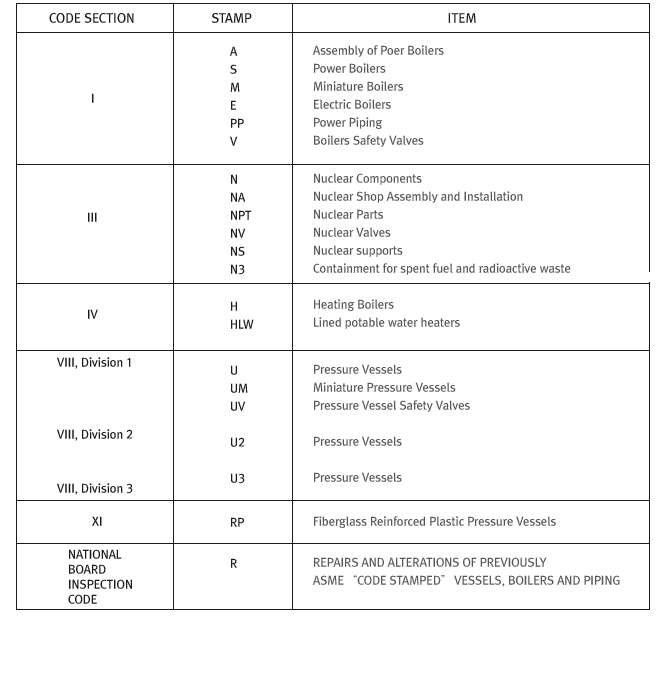
4. ASME 자격의 취득
4.1 장소의 제한
원자력발전소의 소유자 자격은 원자력규제위원회(NRC)에 건설허가(CP)신청서를 제출하여, 품질보증 수립 시점에 ASME에 신청하여 취득하며 발전소 현장에 취득해야 한다. 원자력발전소의 현장 설치자의 경우에도 현장별로 취득해야 하나, 처음에 특정 설치현장을 고정하지 않고 전체 품질프로그램만을 심사 받은 후에 설치현장마다 다시 실사(Survey)를 받아 인증서를 취득한다.
4.2 자격 범위
또한 재료의 경우에는 판(Plate), 단조품(Forging), 파이프, 용접봉 같은 제품의 형태와 탄소강, 저합금강, Ni합금과 같은 화학성분, 특히 발주자 인정시스템의 유무도 인정범위를 제한하는 요소가 되어 있다. 인정서의 범위가 정확하게 기술되어 있지 않으면 계약이 이루어졌을 때, 인정서의 범위와 계약범위가 서로 다를 경우가 발생한다.
4.3 Certificate 취득 시점
4.4 갱 신
4.5 명판(Nameplate) 및 Certification Marks
4.6 Data Report(NCA-8400)
5. 공인검사(NCA-5000)
5.1 공인검사제도
5.2 공인검사기관(AIA)
5.3 공인원자력검사 감독원(ANIS)
2) 인정서 보유자의 품질보증계획서에 대한 변경사항의 검토 및 승인
3) 관할 ANI에 대하여 1년에 2회이상 감사 실시
4) 재료를 제조 또는 공급하는 Certificate Holder에 대한 감사(1년에 1회 이상)
5) 관할인정서 보유자에 대한 업무기록의 관리유지
5.4 공인원자력 검사원(ANI)
2) 인증서 보유자 및 그 하청자의 품질보증계획 감시
3) 인정서 보유자의 자격인정 기록 검토
4) 재료의 확인
5) 작업, 시험 및 검사에 입회 또는 확인
6) 최종압력시험 및 입회
7) Data Report 및 Construction Report 인정
8) 도면검토 및 업무의 도면과의 일치성 검사
9) RPE가 인정하지 않는 Design Report의 Availability 확인
10) Safety Valve의 시험기록 확인
11) Owner의 Code 활동 감시
12) 기타 ANSI/ASME N626에 의해 요구되는 사항
6. 각 인증의 비교
| ||||||||||||||||||||||||||||||||||||||||||||||||||||||||||||||||
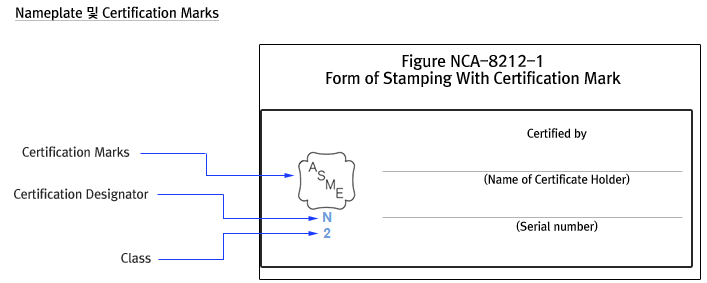
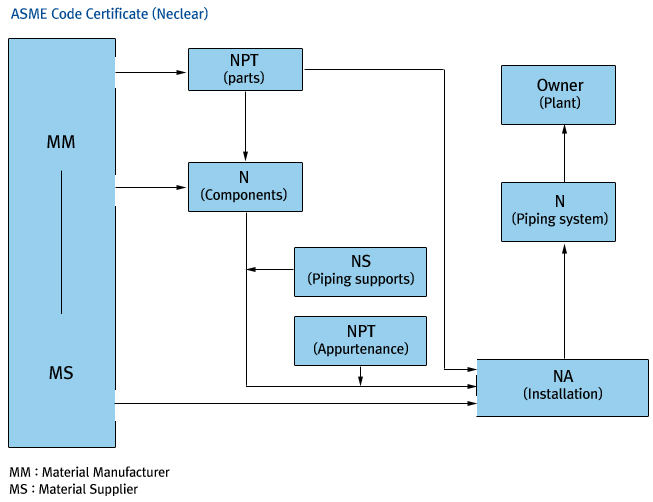
7. ASME Sec. III 인증추진 절차
7. 1. 인증추진 절차
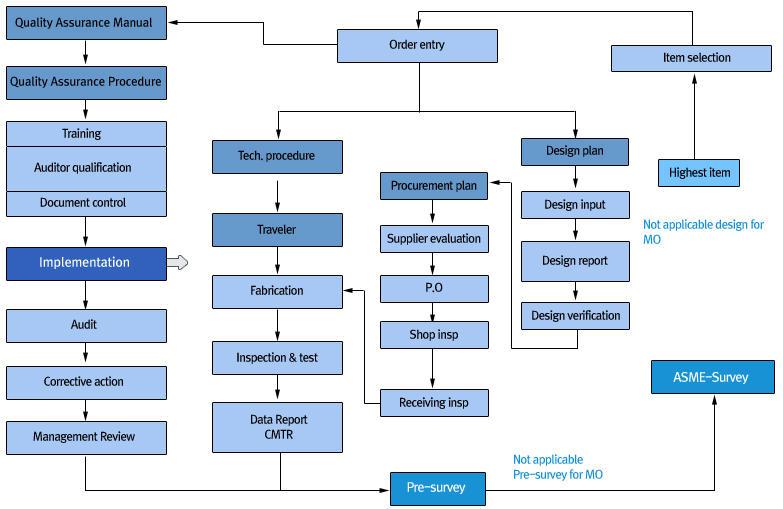
7.2 ASME Survey 절차
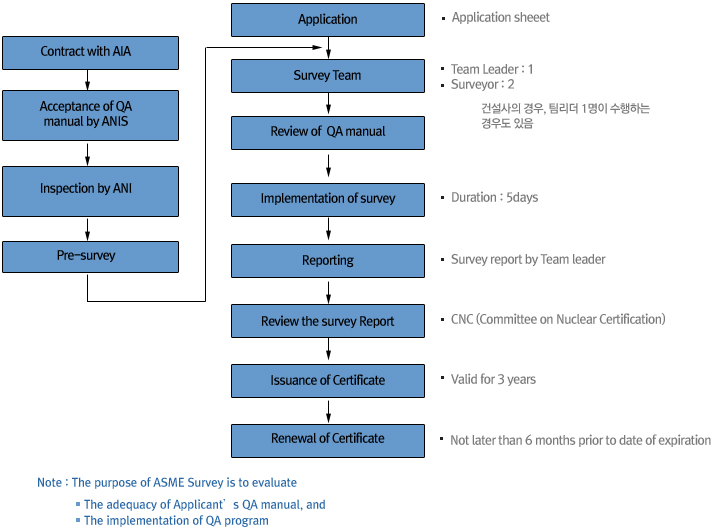
8. ASME에 대하여 자주 나오는 질문 (2013년 5월 현재)
1971년 미국과 캐나다에서 ASME인증서 발행 이후 현재 75개 국가의 제조업체에 ASME 인증서가 발행되었다 세계는 현재 하나의 Global standard화 되어 가고 있다. 현재 Chinese, French, German, Japanese, Korean, Portuguese, Spanish 및 Swedish로 발행하고 있다 (http://www.asme.org/kb/standards/history-of-asme-standards)
Q : Who makes Standards? 누가 표준을 만드는가?
A : ASME's Council on Standards and Certification oversees 6 supervisory boards and 4 advisory boards, which manage more than 700 committees and over 4,700 volunteer members-most of who are working engineers. ASME Standards Development Committees strive for a balance of varied interests and perspectives. Discussion and debate are crucial to this consensus-based process, making diversity an indispensable asset, but the common thread of committee members is technical expertise. Some of the best technical minds in the world volunteer their time and acumen to develop standards that enhance public safety and promote global trade.
Q: Why Standardize? 왜 표준화인가?
A : In 1884 ASME launched its first published standard, for the uniformity for testing methods of boilers. After that, the society turned its attention to pipes and pipe thread. Non-standardized pipe thread contributed to the Great Chicago Fire, the great Baltimore fire and others, as fire companies found their hose couplings wouldn’t fit hydrants outside their specific location. Computers, hand tools, medical devices, elevators, and boilers-virtually all modern mechanical devices involve one or more engineering standards in their manufacture. ASME is the premier organization working to maintain the machinery of the modern world. The fact that the general public is unaware of their work is the best tribute to the success of their achievement-bringing stability to the systems of daily life.
Q: 새로운 스탬프는 언제부터 적용하는가?(When can I begin using the new stamp?)
A : Certified companies may begin to use the new certification mark once the 2011 Addenda to the Boiler & Pressure Vessel Code is published. Revisions have been incorporated describing the use of the mark and the Certification Designator. 인증업체는 2011년 추록 적용시점부터 적용할 수 있다
Q: My company is currently certified. May we request the new stamp now?
A : Yes.
Q: Will there be a fee associated with obtaining the new stamp?
A : If you currently have stamps, there will not be any charge. If you are a newly certified company without any current stamps and you request the new one, the regular stamp fee will apply.
Q: When will we be required to discontinue use of the current stamps?
A : The old stamps (U, S, N, etc.) may be used until January 1, 2013.
Q: What sizes do the new stamps come in?
A : They are available in ½ in. and ¾ in. sizes. When requesting one of the new stamps, you should specify the size.
Q: Are we required to return the old stamps?
A : Yes. The stamps are the property of ASME and must be returned once you discontinue use of them. As of January 2013, all of the old stamps must be returned to ASME.
Q: Are we required to return our certificate when we return the old stamps?
A : No. Your Certificate of Authorization authorizes the use of the Code symbol. The new Code symbol is the Certification Mark as depicted in the sample nameplate above. As of January 1, 2012, the Certificates will be redesigned to show the new certification mark.
Q: My company is currently certified. Will the certificate numbers remain the same when I get the new stamp?
A : Yes.
Q: Will this have any effect on my scope of certification?
A : No.
Q: Must the certification designator be stamped on the nameplate?
A : No. The certification designator must appear directly below the certification mark, however it may be printed rather than stamped. See the applicable Code rules for further information.
Q: My company manufactures small valves which are too small to be stamped. We are currently permitted to use alternative marking processes if accepted by the National Board of Boiler and Pressure Vessel Inspectors and authorized by ASME. Will this continue to be in effect?
A : Yes. There will be no change to this practice.
Q: Can we obtain more than one stamp?
A : Yes, additional stamps may be purchased.
Q: My Company is a current Certificate Holder. When will we receive the new stamp?
A : Current Certificate Holders will receive the new stamps automatically during 2012 when they renew. Other companies may request the new stamp by sending an email to ca@asme.org. Near the end of 2012, all companies that have not previously received one will be sent the new stamp and requested to return their old stamps. There is no charge for current Certificate Holders.
Q: I am fabricating a to an earlier edition of ASME Section III which requires an ASME symbol Stamp “such as NPT” to be applied, however I only possess the new ASME Mark what is the requirement for stamping?
A : Effective January 1, 2013 the ASME mark with the appropriate designator need be used. However, prior to the mandatory January 1, 2013 date either marking will be acceptable.
Q: Do the old and new marks have the same meaning? For example, does the old mark (“N” inside the clover-leaf border) have the same meaning as the new mark (“ASME” diagonally inside the clover-leaf border) with the “N” certification designator underneath?
A : Yes.
Q: What is a standard?
A : A standard can be defined as a set of technical definitions and guidelines, “how to” instructions for designers, manufacturers and users. Standards promote safety, reliability, productivity and efficiency in almost every industry that relies on engineering components or equipment. Standards can run from a few paragraphs to hundreds of pages, and are written by experts with knowledge and expertise in a particular field who sit on many committees.
Q: Are standards mandatory?
A : Standards are considered voluntary because they serve as guidelines, but do not of themselves have the force of law. ASME cannot force any manufacturer, inspector, or installer to follow ASME standards. Their use is voluntary. Standards become mandatory when they have been incorporated into a business contract or incorporated into regulations.
Q: What is a code?
A : A code is a standard that has been adopted by one or more governmental bodies and has the force of law.
Q: Why are standards effective?
A : Standards are a vehicle of communication for producers and users. They serve as a common language, defining quality and establishing safety criteria. Costs are lower if procedures are standardized; training is also simplified. Interchangeability is another reason. It is not uncommon for a consumer to buy a nut in California for a bolt purchased in New Jersey.
Q: How is ASME organized to produce codes and standards?
A : Within ASME, the Council on Codes and Standards is one of five councils that report to the Board of Governors. Under this Council, there are six standards developing supervisory boards that manage over 100 consensus committees with 3700 volunteer members and four advisory boards. The supervisory boards are responsible for pressure technology, nuclear installations, safety codes and standards, performance test codes, conformity assessment and standardization The supervisory boards in turn have standards committees, each responsible for an area of standards development. The advisory boards deal with metrication, international standards, hearings and appeals and council operations.
Q: Is ASME part of the government?
A : No, ASME is an independent, not-for-profit organization. ASME is one of the oldest and most respected standards developing organizations (SDO) in the world. It produces and maintains approximately 600 codes and standards, covering a multitude of technical areas including boiler components, elevators, hand tools, fasteners, and machine tools to name just a few.
Q: Who are the members of Standards Committees?
A : The standards committees are composed of volunteers from various segments of the particular industry. The volunteers are dedicated people from many walks of life. ASME standards committees are required to maintain a balance of members in various interest classifications so that no one group dominates. Some examples of the various interest classifications are: users, manufacturers, consultants, insurance interests, universities, testing laboratories, and government regulatory agencies. Volunteers must agree to adhere to the ASME Policy on Conflict of Interest and the Engineer’s Code of Ethics.
Q: Where does a request for a new code or standard come from?
A : A request for a code or standard may come from individuals, committees, professional organizations, government agencies, industry groups, public interest groups, or from an ASME division or section. The request is first referred to the appropriate supervisory board for consideration. The board then assigns the request to an existing committee of knowledgeable volunteers or determines that a new standards committee must be formed. once an appropriate Committee has concluded that there is enough interest and need the standards developing process is initiated.
Q: What type of procedures do ASME Standards Committees follow?
A : Procedures must reflect openness, transparency, balance of interest, and due process. Committee meetings addressing technical issues must be open to the public, and procedures are used to govern deliberations and voting. Committees must represent a balance of interested parties, and all comments on technical documents during the final approval process must be considered. Any individual may appeal any action or inaction of a committee relating to membership, or a code or standard promulgated by the committee.
Q: What does "Consensus" mean?
A : Consensus [as defined by American National Standards Institute (ANSI)] means substantial agreement has been reached by directly and materially affected interest categories. This signifies the concurrence of more than a simple majority, but not necessarily unanimity. Consensus requires that all views and objections be considered, and that an effort be made toward their resolution
Q: What type of voting procedures do ASME Standards Committees follow?
A : Voting procedures for the standards committee are designed to ensure consensus as defined by ANSI. Voting is conducted at meetings and votes are also sent by mail, email and through the ASME web site. Repeated voting may be necessary to resolve negative votes. If an individual member feels that due process was not observed, appeals may be made to the standards committee, supervisory board, and subsequently, to the Board on Hearings and Appeals. The proposed standard (or revision) is also subject to a public review in Mechanical Engineering magazine, and on the ASME web site, and usually in ANSI's Standards Action publication. Anyone may submit comments during the public review period, to which the committee must respond. The draft is also submitted for approval to the supervisory board and ANSI. When all considerations have been satisfied, the document is approved as an American National Standard and published by ASME.
Q: Why are codes and standards revised?
A : Codes and standards are living documents that are constantly revised to reflect new developments and technical advances (e.g., new materials, new designs and new applications).
Q: What is ANSI?
A : The American National Standards Institute (ANSI) is a privately funded federation of business and industry, standards developers, trade associations, labor unions, professional societies, consumers, academia, and government agencies. ANSI does not itself write standards. ANSI is the United States member of ISO.
Q: Is ASME Accredited by ANSI?
A : ASME is an accredited Standards Developing Organization that meets the due process requirements of the American National Standards Institute (ANSI). Codes and Standards that are developed under an accredited program may be designated as American National Standards.
'경영혁신 > 품질혁신' 카테고리의 다른 글
| 품질방침 사례 (0) | 2018.11.01 |
|---|---|
| ASME STAMP (0) | 2017.03.19 |
| ASME[American Society of Mechanical Engineers] 미국기계학회 및 그 규격 약칭. 세계적으로 통용되는 규격 (0) | 2017.03.19 |
| 설계품질(design of quality)의 개념 (0) | 2017.01.04 |
| 타이타닉호의 비극은 '품질 실패'때문이다. | (0) | 2012.01.16 |